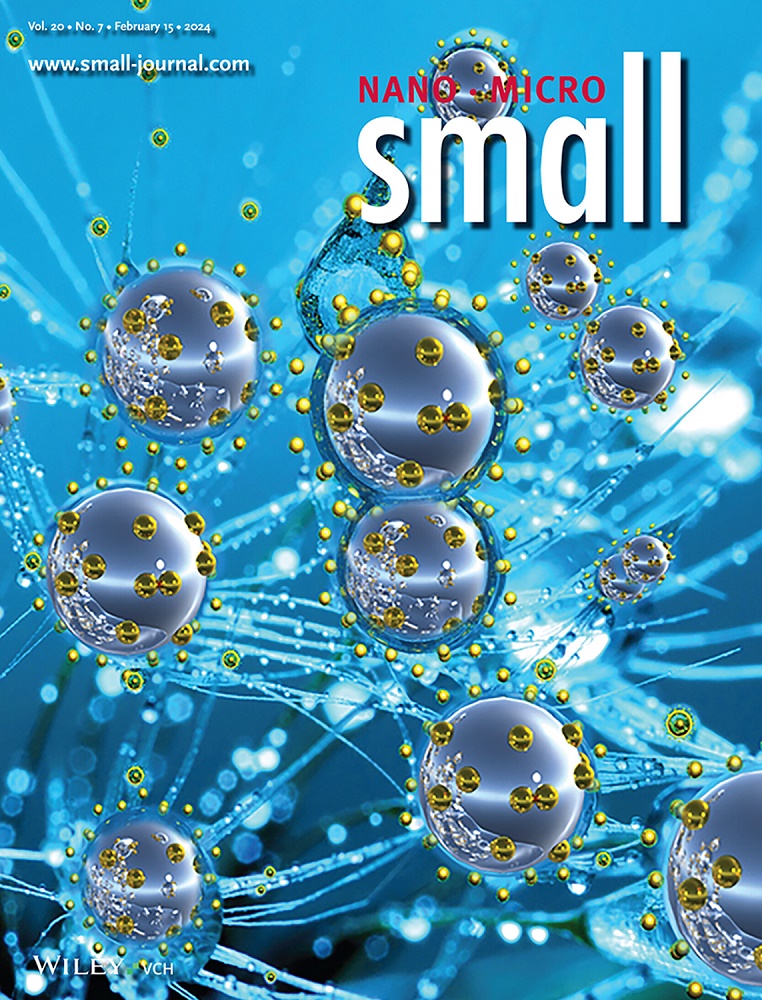Engineering Precursor Localization via Solvency for Simultaneously Metallizing and Hollowing Bicontinuous Gyroid Structures.
IF 12.1
2区 材料科学
Q1 CHEMISTRY, MULTIDISCIPLINARY
引用次数: 0
Abstract
Metallized ordered porous nanonetworks offer exceptional performance due to their robust bicontinuous interconnected frameworks with a large surface area. However, further enhanced porosity remains a challenge. The most efficient approach is to simultaneously hollow and metallize these nanonetworks, dominated by precisely controlling the associated distribution of the guest metallic precursor. Here, the challenges in maintaining the structural integrity of the double gyroid (DG) structure while enhancing porosity are overcome by direct metallizing and hollowing the DG hybrid into tungsten oxide (WO₃) hollow double gyroid (HG) architectures using polystyrene-block-poly(4-vinyl pyridine) (PS-b-P4VP) block copolymers. Unlike typical hybridization where guest precursors distribute uniformly, the approach leverages the ionization of bicontinuous P4VP frameworks and the solvency of metallic precursors to precisely control precursor association. This results in two distinct hybridizations: homogeneous dispersion within the P4VP framework or heterogeneous localization at microphase-separated interfaces. The heterogeneous localization can lead to the formation of the unique core-shell triclinic DG hybrid, distinct from the conventional cubic DG. Through sequential calcination, the core-shell DG hybrid can be simultaneously metallized and hollowed into crystalline WO₃-based HG structures with exceptional porosity. This engineering precursor distribution is also valid for amphiphilic copolymer-derived ordered and disordered nanonetworks, paving advanced applications in nanopatterning, metamaterials, and catalysis.同时金属化和空心化双连续陀螺结构的工程前驱体定位。
金属化有序多孔纳米网络由于其强大的双连续互联框架和大表面积而提供了卓越的性能。然而,进一步提高孔隙度仍然是一个挑战。最有效的方法是同时中空和金属化这些纳米网络,主要是精确控制客体金属前驱体的相关分布。在这里,通过使用聚苯乙烯-嵌段-聚(4-乙烯基吡啶)(PS-b-P4VP)嵌段共聚物直接金属化和将DG杂化成氧化钨(WO₃)中空双螺线管(HG)结构,克服了在保持双螺线管(DG)结构完整性的同时提高孔隙率的挑战。与典型的客体前体均匀分布的杂交不同,该方法利用双连续P4VP框架的电离和金属前体的溶解性来精确控制前体结合。这导致了两种不同的杂化:P4VP框架内的均匀色散或微相分离界面上的异质定位。异质定位可以形成独特的核壳三斜型DG杂化结构,区别于传统的立方DG。通过连续煅烧,核壳DG杂化可以同时被金属化和中空成具有特殊孔隙率的结晶WO₃基HG结构。这种工程前驱体分布也适用于两亲共聚物衍生的有序和无序纳米网络,为纳米图案、超材料和催化等领域的先进应用铺平了道路。
本文章由计算机程序翻译,如有差异,请以英文原文为准。
求助全文
约1分钟内获得全文
求助全文
来源期刊

Small
工程技术-材料科学:综合
CiteScore
17.70
自引率
3.80%
发文量
1830
审稿时长
2.1 months
期刊介绍:
Small serves as an exceptional platform for both experimental and theoretical studies in fundamental and applied interdisciplinary research at the nano- and microscale. The journal offers a compelling mix of peer-reviewed Research Articles, Reviews, Perspectives, and Comments.
With a remarkable 2022 Journal Impact Factor of 13.3 (Journal Citation Reports from Clarivate Analytics, 2023), Small remains among the top multidisciplinary journals, covering a wide range of topics at the interface of materials science, chemistry, physics, engineering, medicine, and biology.
Small's readership includes biochemists, biologists, biomedical scientists, chemists, engineers, information technologists, materials scientists, physicists, and theoreticians alike.
 求助内容:
求助内容: 应助结果提醒方式:
应助结果提醒方式:


